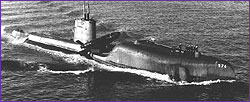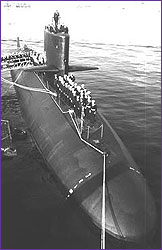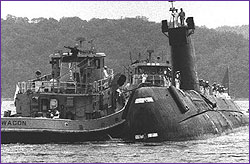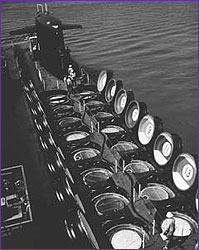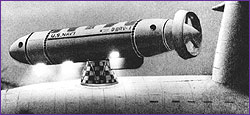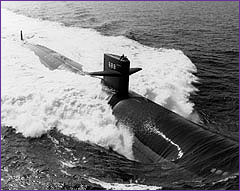 |

|
400 Years of Subs Introduction | 1580-1861 | 1861-1900 |1900-1918 1918-1939 | 1939-1945 | 1945-1972 | 1972-2000 1946 Dr. Philip Abelson proposed a marriage of the Walter hull form with a nuclear power plant. The Navy detailed eight engineers to the home of the atomic bomb, the Atomic Energy Commission facility in Oak Ridge, Tennessee, to see what might be developed. 1947 Testing some newly discovered peculiarities concerning the transmission of sound in the open ocean, a U.S. submarine was able to detect a destroyer at a distance of 105 miles and hear depth charges exploding 600 miles away. This, and other research, led to the development of a deep-ocean array of hydrophones called SOSUS (for SOund SUrveillance System). One of the earliest installations could detect a snorkeling submarine at 500 miles.
The U.S. Navy began experimenting with submarine-launched missiles, starting with a copy of the German V-1 buzz bomb now called Loon. Crew members tracked Loon by radar and command-controlled it from the submarine. Erection of the launching ramp and preparation of the missile kept the submarine on the surface for five minutes, however. The Navy therefore developed a hand-off control system, in which another submarine 80 miles downrange could take over for the missile's final 55 miles of flight. 1950 The Soviet Union moved to regain status as operator of the world's largest submarine fleet. Over the following eight years, they built 235 Whiskey class submarines using the Type XXI as a template. 1950 USS Pickerel, SS-524, ran from Hong Kong to Pearl Harbor—21 days, 5,194 miles—on snorkel. 1950 One of the officers detailed to Oak Ridge in 1946, Captain Hyman Rickover, assumed control of the Navy nuclear propulsion program—and kept control until finally retired in 1982. Rickover was a submariner and an engineer, with a passion for safety and an obsession for control. Brilliant and difficult, he made nuclear power a reality, not just in submarines but in many major surface warships as well. 1952 The first of the post-war U.S. submarines—USS Tang, SS-563—set an American depth record of 713 feet. 1953 The next generation sub-launched missile, Regulus I, could carry a 3,000-pound nuclear warhead for 500 miles.
The U.S. Navy began operation of a fast-submarine test bed (a boat without combat capability but easily reconfigured to try out various control schemes): the 203-foot USS Albacore, AGSS-569. Bearing a hull form resembling that of an airship, the boat went through five experimental configurations. In the first, she demonstrated underwater speeds of 26 knots. 1954 The first nuclear-powered submarine, the USS Nautilus, SSN-571, went to sea. The 323-foot, 3,674-ton boat boasted a speed of 18 knots (surface) and 23 knots (submerged). On her shakedown cruise, she steamed 1,381 miles from New London to San Juan, Puerto Rico, submerged all the way at an average speed of 15 knots. She was so fast that, on her first exercise with an anti-submarine warfare (ASW) force, she outran the homing torpedoes. Note the use of the term 'steamed.' The nuclear plant finally made a steam-powered submarine practical. The reactor generates heat that turns water into steam to drive the turbine. Two different reactor configurations were proposed. One used pressurized water to transfer heat from the reactor to the steam plant, the other used a liquid sodium potassium alloy.
The U.S. Navy experimented with various propulsion systems, including so-called closed-circuit engines, which did not require access to atmospheric oxygen. Development of the nuclear power plant tended to put other technologies on the shelf, however, at least in the United States. The development of closed-circuit systems has continued, especially in some European navies seeking a lower-cost alternative to nuclear power. 1955 Based on hard experience with the Japanese kamikaze aircraft, the U.S. Navy developed a prototype nuclear-powered radar-picket submarine. At 447 feet and 5,963 tons, USS Triton, SSN-585 was the largest U.S. submarine to date, but by the time she was in commission in 1959, advances in airborne detection systems had rendered her intended mission unnecessary. In 1969 she became the first nuclear boat to be retired.
The German V-2 rocket became the U.S. Air Force Jupiter missile. Although the missile was exceedingly large, at least one scheme proposed mounting four V-2s in a submarine. Timely development of the Polaris missile, which permitted 16 on a boat, precluded any further discussion of submarine-based V-2s.
1958 The Soviet Union fielded its first nuclear-powered submarine. The Soviets gained a head start by following and copying the Americans. Five years into its program, the Soviet Union had 24 nuclear boats in three classes, all bearing the same reactor. Unfortunately for submarine crews, the Soviets apparently failed to appreciate the hazards associated with nuclear power. Rumors have circulated that entire crews of early Soviet boats later died from radiation poisoning. 1959 The first submarine to utilize the potential of both the nuclear power plant and the high-speed Albacore hull was USS Skipjack, SSN-585, which was officially rated at 29 knots submerged.
USS Triton completed the first submerged circumnavigation of the globe: 36,014 miles in 84 days. 1963 On April 10, the USS Thresher, SSN-593 became the first of two nuclear submarines the U.S. Navy has lost to accident (see Submarines, Secrets, and Spies). After two years in commission, the boat had just spent some time in a shipyard and was on sea trials when something went wrong, perhaps the rupture of a section of piping. No one knows for certain. Thresher sank in 8,300 feet of water, taking 128 crew members with her. The boat had an operational depth of 1,300 feet, more than any other U.S. submarine class to that date, but clearly the hull would have passed "crush depth" well before hitting bottom.
1965 USS Albacore reportedly set an underwater speed record of 33 knots, though the posted 'official' speed is 25 knots. 1968 On May 22, the USS Scorpion, SSN-589, became the second U.S. nuclear boat lost (see Submarines, Secrets, and Spies). Possibly the victim of one of her own torpedoes, Scorpion in its last moments may have been picked up by the then-secret SOSUS sound arrays planted on the ocean floor.
A Soviet November class nuclear submarine surprised the U.S. Navy by keeping up with a high-speed task force going 31 knots and led by the nuclear-powered aircraft carrier USS Enterprise. Spooked, the Navy developed a new class of fast attack boats, Los Angeles. The class had some teething problems, but the 62 boats in the class demonstrated respectable performance, with submerged speeds in excess of 30 knots. 1971 The C-3 missile, Poseidon, with multiple independently targeted warheads, went to sea. Continue: 1972-2000 Tour U-869 | Sole Survivor | Hazards of Diving Deep 400 Years of Subs | Map of Lost U-Boats | Fire a Torpedo Resources | Transcript | Site Map | Hitler's Lost Sub Home Editor's Picks | Previous Sites | Join Us/E-mail | TV/Web Schedule About NOVA | Teachers | Site Map | Shop | Jobs | Search | To print PBS Online | NOVA Online | WGBH © | Updated November 2000 |

